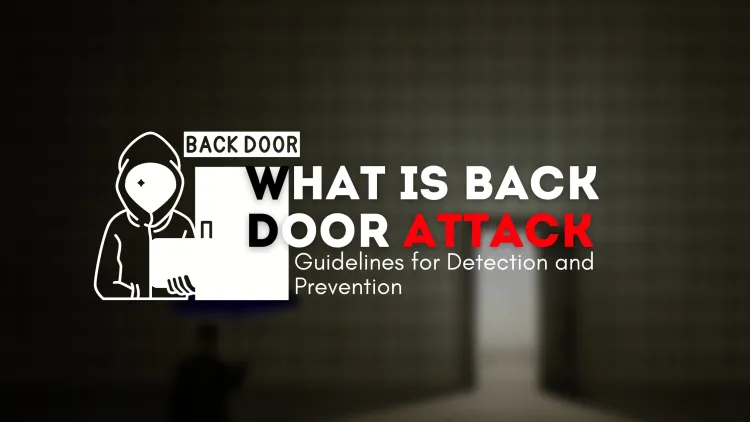What is Backdoor Attack? Guidelines for Detection and Prevention
A backdoor attack allows hackers to bypass security systems and gain unauthorized access to sensitive data. These attacks are often hard to detect, as backdoors are designed to be stealthy. Detecting backdoors requires tools like IDS, network monitoring, and regular security audits. Prevention strategies include software updates, multi-factor authentication, and employee training. Understanding and implementing these measures is essential for protecting systems from this growing cybersecurity threat.

In the world of cybersecurity, a backdoor attack is one of the most sneaky and dangerous threats. Backdoor attacks allow hackers to bypass normal authentication processes, gaining unauthorized access to systems, networks, or applications without detection. This blog will delve into what backdoor attacks are, how they work, their impact, and most importantly, how to detect and prevent them to safeguard your digital assets.
What is a Backdoor Attack?
A backdoor attack involves the creation or exploitation of a hidden entry point (backdoor) into a system. These backdoors can be planted by attackers or left behind intentionally by developers for maintenance purposes. Hackers use these entry points to:
- Steal sensitive data
- Install malicious software
- Gain control over systems
- Launch additional cyberattacks like ransomware or DDoS attacks
How Do Backdoor Attacks Work?
Hackers use various techniques to carry out backdoor attacks, including:
-
Exploiting Software Vulnerabilities
Attackers exploit weaknesses in software to plant backdoors. -
Malicious Downloads
Backdoors are hidden in seemingly legitimate files or software. -
Social Engineering
Victims are tricked into downloading infected files. -
Compromising Third-Party Applications
Attackers target vulnerabilities in third-party plugins or apps.
Impact of Backdoor Attacks
The consequences of backdoor attacks can be severe, including:
- Loss of sensitive data
- Financial losses due to fraud or theft
- Damage to reputation and customer trust
- Legal and regulatory penalties for data breaches
Guidelines for Detecting Backdoor Attacks
Detecting backdoor attacks can be challenging, but the following steps can help:
-
Monitor Network Traffic
Look for unusual patterns or unauthorized data transfers. -
Use Intrusion Detection Systems (IDS)
These tools help identify suspicious activities. -
Regularly Audit Logs
Check for any unauthorized access or modifications. -
Analyze Files for Malware
Use antivirus and anti-malware tools to scan files and applications. -
Employ Behavioral Analysis Tools
These tools identify anomalies in system behavior that may indicate a backdoor.
Guidelines for Preventing Backdoor Attacks
Prevention is the key to staying safe from backdoor attacks. Here’s how:
1. Keep Software Updated
Regular updates fix vulnerabilities that attackers could exploit.
2. Use Strong Authentication Methods
Enable multi-factor authentication (MFA) to prevent unauthorized access.
3. Conduct Regular Security Audits
Identify and fix potential security gaps.
4. Educate Employees on Cybersecurity
Train staff to recognize phishing attempts and other social engineering tactics.
5. Deploy Robust Security Tools
Use firewalls, endpoint protection, and antivirus software to block potential threats.
6. Limit Third-Party Access
Ensure that only trusted third-party vendors have access to your systems.
Why Are Backdoor Attacks Hard to Detect?
Backdoors are designed to be discreet, making them hard to spot. Attackers often encrypt their activities, hide files in obscure locations, or mimic legitimate system processes, making manual detection nearly impossible without specialized tools.
Real-Life Examples of Backdoor Attacks
- SolarWinds Attack (2020): Hackers exploited a backdoor in SolarWinds’ Orion software to access sensitive data in several government and corporate networks.
- ShadowPad Attack (2017): A backdoor was planted in a popular server management tool, affecting thousands of organizations.
Conclusion
Backdoor attacks are a growing threat in the digital world, but with the right knowledge and tools, you can protect your systems. By implementing the guidelines for detection and prevention, you can minimize the risk of falling victim to these stealthy cyberattacks. Stay vigilant, educate your team, and prioritize cybersecurity to safeguard your data.
FAQs
-
What is a backdoor in cybersecurity?
A backdoor is a hidden entry point into a system that allows unauthorized access. -
How do hackers plant backdoors?
They exploit vulnerabilities, use social engineering, or embed backdoors in malicious downloads. -
Why are backdoor attacks dangerous?
They bypass security measures, allowing hackers to steal data or control systems unnoticed. -
How can I detect a backdoor attack?
Use network monitoring, intrusion detection systems, and regular log audits. -
What tools help in preventing backdoor attacks?
Firewalls, antivirus software, and endpoint protection tools are effective. -
Can backdoors be left by developers intentionally?
Yes, sometimes developers leave backdoors for maintenance purposes, which can be exploited by attackers. -
What industries are most targeted by backdoor attacks?
Financial institutions, healthcare, and government sectors are common targets. -
How often should security audits be conducted?
At least quarterly, but more frequently for high-risk organizations. -
What is the role of multi-factor authentication in prevention?
It adds an extra layer of security, making unauthorized access harder. -
What is a real-life example of a backdoor attack?
The SolarWinds attack in 2020 is a notable example where hackers used a backdoor to compromise multiple organizations.











![Top 10 Ethical Hackers in the World [2025]](https://www.webasha.com/blog/uploads/images/202408/image_100x75_66c2f983c207b.webp)



![[2025] Top 100+ VAPT Interview Questions and Answers](https://www.webasha.com/blog/uploads/images/image_100x75_6512b1e4b64f7.jpg)







